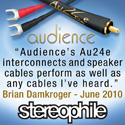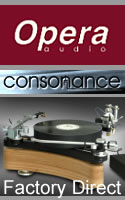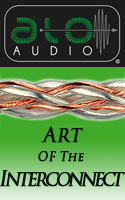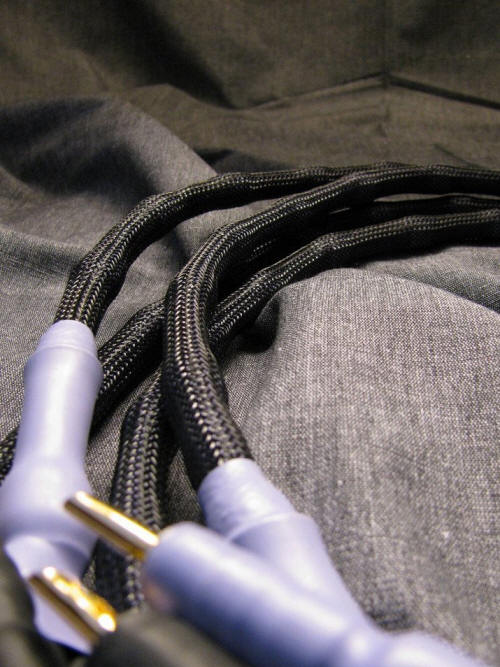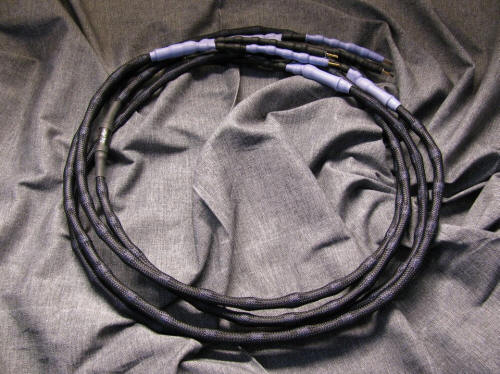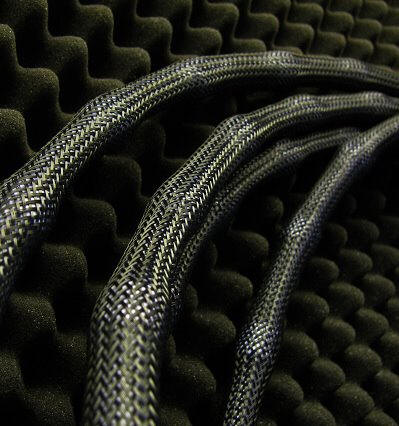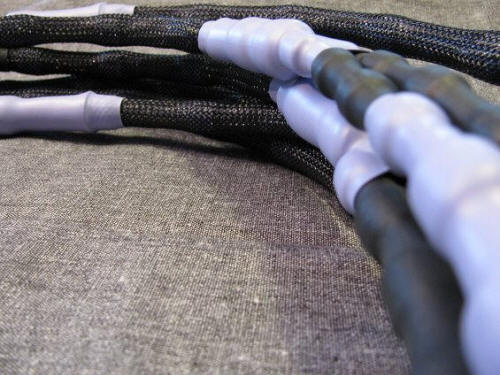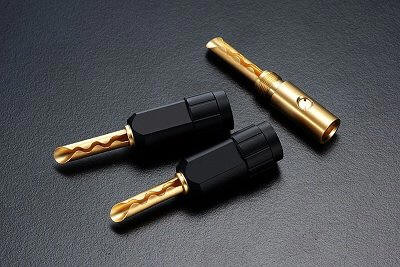|
|
You are reading the older HTML site
Positive Feedback ISSUE 60
skogrand SC Air Speaker Cables as reviewed by Art Shapiro
One of the true pleasures of a reviewer's position is to occasionally stumble upon absolutely unfamiliar companies whose products are unquestionably worthwhile and can give a great deal of listening pleasure. So when Positive Feedback Online directed a set of speaker cables from the unknown (to me) company Skogrand Cables, I was happy to give them several months of listening. Would these be a hidden gem? I learned that this Norwegian company reflected the name of the founder. One might posit that the company is trying to establish a market and reputation in the United States; that's fine with me, as long as I don't have to eat lutefisk! By way of background, I'd been using Luminous Audio Synchestra Signatures in my system for a number of years; I reviewed them way back in PFO Issues 14 and 15 and ended up purchasing them. I still think they offer remarkable bang for the buck, but late last year it became time to shoot the audio budget and purchase Kubala-Sosna Emotion speaker cables at many multiples of the Luminous' price. Indeed, I delayed this review for a while, to the Editor's chagrin, while trying to break in the new guys. The first impression was positive, as the SC Airs arrived in a heavy injection-molded plastic case with quite sturdy flip latches. This sort of case is often seen in high-end camera equipment or as an option for storing and transporting power tools such as belt sanders or drills. That struck me as a practical transport solution that would easily enable the product to withstand the rigors of transoceanic shipping, impress the purchaser, yet not be absurdly expensive for the manufacturer.
As the review set was alleged to be for single-wired systems, that being one of the stated requirements for prospective PFO reviewers, I was rather surprised to open the case and find four individual cables with bananas on all ends. I was under the impression that this must be a bi-wired set for those rare amps with dual speaker outputs. PFO Head Honcho David Clark subsequently showed me that there were actually two separate products in the case, a pair of the entry level (but decidedly pricey) SC Air cables, and a pair of slightly thicker and considerably more expensive SC Air Centaurus A cables. The distinction was obvious only after the slight difference in appearance was pointed out to me. My instructions were to pick one of the two sets. As one of the SC Air cables had a damaged plug—more about that in just a bit—it seemed logical to pick the better-condition pair. Also, I've never been one to bypass a chance to try expensive audio equipment! But upon trying them both, forcing the one damaged plug into the amplifier jack as best as possible on the lower-priced pair, I decided I actually preferred the "lesser" SC Air cable and focused on it for this review. Just a brief word about the Centaurus A product: it has a more refined sound than the SC Air, which is a laudable characteristic. But it seemed a bit soft in my system, with somewhat less kick and power. I was pleased to stay with the SC Air. The Skogrand SC Air cables are less expensive than my Kubala-Sosna product, so they were up against a quite impressive competitor that furthermore was a very good match for my system. The aesthetics of the cables rub me the right way. Two obviously-heavy conductors have—unusually—black and lavender heatshrink to delineate the two sides. Actually, it looks like black on both sides with a further covering of lavender on one side. A heavy dark-purple braid spans the length of the cable, with another big lavender piece of heatshrink forming the transition area between the two conductors and the braided body. One can discern some sort of ring-like piece under the braid every few inches, probably intended to center the conductors and suspend them away from the floor or shelf or whatever. Toward one end of one of the two sides is the manufacturer's logo in silver lettering on a black cylinder around the braid, with black heatshrink anchoring it on both sides. It's an attractive product in my book.
As stated earlier, these cables had bananas at both ends. They appear to be "Z" plugs, which differ markedly from the traditional banana plug which has four individual prongs, flaring out in the middle, and tapering toward the insertion end. Z plugs are essentially gold-colored cylinders with a tiny corrugated gap in the cylinder, so that it can compress and expand a little bit. I suspect the philosophy is that the cylinder offers more contact area in the jack than the traditional four prongs, and that's probably true. Alas, I found that one of the sixteen plugs had been "scrunched" and was marginally useable. It is clearly more difficult to insert a Z plug than a traditional banana, simply because there's no tapered end to guide the plug into the banana jack. One has to hit it "dead on". In fairness, I suspect the review set has been through many hands, some of whom like myself needed to unplug and replug the Skogrands a hundred or more times. For the normal consumer, who will rarely need to repetitively remove and reinsert the cable, it's a complete non-issue. He or she will carefully insert the Z plugs into their respective jacks and life will be fine. Sorry, Skogrand; it wasn't I who mangled the one plug! I found the plugs easy to insert into my Manley monoblocks. but quite difficult to force into the somewhat-tighter jacks on my Consensus speakers. Again, a bit of a hassle for me but probably not a big deal for the typical purchaser. I'd gotten quite used to the superb sonic presentation of my Kubala-Sosna cables by the time I seriously devoted time to the Skogrands. The former are slightly to the warm side of neutral, just as I like my sound; they sacrifice a little bit of clarity in favor of harmonic richness. What would I find with the new, unfamiliar Skogrand product? Initially, I had absolutely no idea whether these were a budget product or a jaw-dropping megabuck cable, although the case and the physical attributes told me that, whatever they cost, it wasn't trivial. I don't remember what I first played, but as more than 90% of my listening is to solo "classical" piano, that's a pretty good guess. After just a minute or two, the first thing that popped into my mind was "these cables sound expensive!" I realize that's a discouragingly vague statement to the reader, but suffice it to say that was a positive first impression to this listener. It became quickly apparent that the SC Air cables offered an extraordinarily powerful presentation. The editor would probably frown on my colloquialism if I were to describe them as "ballsy", so perhaps I can get away with saying that they possessed ample testicular fortitude. This was a consistent impression during my weeks living with the SC Airs.
My friend and fellow PFO reviewer Mark Katz heard the Skogrands on at least four occasions. He is much more sensitive to soundstaging and spatial issues than I, and confirmed my impression that they offered a huge spatial presentation. He also concurred with the observations that you'll be reading in this review. The Skogrands were noticeably drier than my Kubala-Sosnas. Make no mistake; the presentation was totally within the bounds of good taste, never even remotely slipping over the edge into lean sterility. Throughout my tenure with the product, I was conscious that they had less harmonic richness than my own cables, seeming to emphasize the leading edge of notes while lessening the decay. One listener phrased this characteristic in an interesting way that I thought accurate: he offered the opinion that the Skogrands would greatly appeal to audiophiles who like solid-state equipment, while my existing cables were a tube aficionado's delight. Indeed, Mark Katz offered the opinion that if these were my speaker cables—and that would hardly be a bad thing!—then we'd probably warm things up just a smidge by replacing one tube in the E.A.R. preamp with something like a Mullard. Another consistent impression with the SC Airs was that of exceptional performance at both the high and the low ends. They gave the system delightful bass slam when the music called for it, yet the delicacy at the extreme high end, such as the uppermost octave of the piano keyboard, was gorgeous. I lamented the slight midrange dryness (remember that the Kubala-Sosna's are slightly to the warm side), which of course is just indicative of my own tonal preferences, while basking in the glory of the two extremes. That slight dryness resulted in my final impressions during my auditioning of these cables. They were spectacular in resolving individual notes in fast and complicated music, be it piano, guitar, harp, or orchestral music. My own warmer cables would slightly blur complex arpeggios, runs, and similar figurations, whereas one could clearly distinguish the notes in the most hair-raising torrents of piano sound through the Skogrands. I found this to be a very appealing characteristic of the SC Airs; they'd be a joy to those who enjoy hearing deep into the music, as well as being a real asset to someone trying to learn the music and decipher its intricacies. Even a classical listener such as myself has to periodically put on a familiar audiophile staple: the Bela Fleck Flight of the Cosmic Hippo on a Warner Brothers CD. I concentrated on the title track and on the opening "Blu-bop" track. The bass slam on the title track was a delight. I was consistently reminded of the clearer presentation, with less warmth and thus somewhat less overall instrumental resonance. The upper-end shimmer of the lightly brushed cymbals was a joy. At the very low end of the frequency range of this piece, the notes were cleaner without being sterile. I felt that the musical presentation was slightly more realistic with my own warmer cables (of course can anyone really know what defines 'realistic' on any recording - Ed), but the Skogrands' strengths could not be denied. On the "Blu-bop" track, one was struck by the fantastic definition and delineation of the instruments. The piano was sparklingly clear and the bass impact was gratifying. Some of the instrumental notes' decay was sacrificed in the name of overall clarity; on the other hand one could hear more subtleties such as the fingers sliding and squeaking on the bass guitar strings that were a touch blurred on my own cables. I turned to a Sony sampler CD, selecting some music from Mahler's Des Knabens Wunderhorn with the legendary baritone Dietrich Fischer-Dieskau singing with the Berlin Philharmonic, conducted by Daniel Barenboim. My own cables seemed to do quite well in this piece. The magnificent voice had more chestiness and was more melodic, and there was similarly more tonality to a bass drum that is struck at various intensities throughout the track. On the other hand, that drum had a more powerful presentation through the Skogrands, and the review cables also excelled at clearly presenting a snare drum in this movement.
I pulled out a personal auditioning staple: a Dorian CD of Bach secular cantatas, choosing several bands from the Coffee Cantata. Once again, I did not feel that the tenor, baritone, and soprano voices were at their best through the Skogrands. The soprano was a tiny bit "flatter" and perhaps a little more shouty than I'd prefer. The gorgeous flute passages in the small baroque orchestration were exceptionally clean, with perhaps more basic tonality and less harmonics than my own cables, and somewhat less airiness to the presentation. Voices conformed to previous observations by having more front edge and less decay than my own cables. The orchestration was very well done through the Skogrands, with the more detailed presentation seeming to work very satisfactorily with this particular work. I think it accurate to assert that voices were somewhat mechanical through the Skogrands; not bad by any means, but bested by my own, and considerably more expensive, cables. On the other hand, the instrumentation acquainted itself unusually well through the Skogrands. I turned to a favorite piano CD, Impressions of France, with Christina Ortiz performing an interesting assortment of French pieces on an MCA CD. There's enough there to encompass most of the capacity of a modern grand piano. In Ravel's Jeux d'eau, I was struck by the gorgeous and delicate tonality in the extreme upper registers of the piano. In Debussy's La Cathédral Engloutie (the Sunken Cathedral), the slam in the heavily-hit low end was a pleasure, and I continued to be impressed by the delicacy of the highest notes. The warmth of my existing cables resulted in a little more sweetness at the top end, and a more blended, harmonically-rich presentation. Even so, the machine-gun repeated notes in Ravel's Alborado del Gracioso were considerably more distinct through the SC Airs. I thought that the Impressionistic music on this CD was perhaps more as the composer intended through the warmish Kubala-Sosnas, while respecting and appreciating the clarity, detail, and power portrayed through the Skogrands. I put on a Harmonia Mundi CD of harp music performed by Isabelle Moretti, concentrating on the Harp Sonata of French composer Germaine Tailleferre, the only female member of the noted group Les Six. I played the impossibly fast last movement, a Perpetuum mobile that is a true virtuosic spectacle. As usual, the Skogrands were slightly less harmonically rich, while their impressive clarity let one really appreciate the torrent of notes being performed. It was a little less subtle and more "in your face" than with my own cables, but always within reason; I was able to concentrate on and savor the crystal-clear fast passages through the Skogrands. Lastly, I took out one of my few Jazz CDs, an Audioquest CD entitled Works of Art, Volume 2. I concentrated on the opening track, "Crescent Crawl", performed by the Bruce Katz Band. As before, the Skogrands sacrificed a little bit of body in favor of impressive clarity. The snare drum, while perhaps a little less realistic, had a delightfully snappy sonic presentation. The sax, slightly less rich than through my own cables, nevertheless had a noticeable punchiness that couldn't fail to impress. There are a number of piano glissandi in which the sparkling clarity of the Skogrands was quite an asset. Well, you probably get the idea by now that I enjoyed my time with the Skogrand SC Air speaker cables. They are a fine product and worked admirably well in my system. I would have personally preferred a little bit more warmth, as was emphasized throughout this review, but believe a little bit of tube-tweaking might well accomplish that goal. The power at the low end was a pleasure, and the delicacy at the extreme high end spoke exceedingly well for the cables. The remarkable clarity without deteriorating into sterility was perhaps their best feature; one could hear very subtle details of the most complicated musical passages through these cables. As it stands, the earlier observation stands that this product would really light up the many audiophiles who strive for top-flight solid-state sound. The Skogrands would also be a potential virtue for a system that's perhaps a little too warm for the owner's tastes. It was with more than a trace of sadness that I packed them away for the last time in that impressive case. Art Shapiro
SC Air
Skogrand
|
